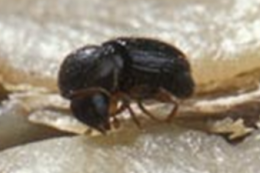Hypothenemus hampei. Image: Wikipedia.
(PhysOrg.com) -- Genes jumping between bacteria are rather common which in part explains their ability to rapidly develop immunity to antibacterial agents. What’s not so common are examples of genes jumping between animals or between bacteria and insects. This is why the findings of a team of researchers studying the coffee berry borer beetle are so surprising. It’s an insect that has, as the team describes in their paper published in the Proceedings of the National Academy of Sciences, developed a means for excreting a protein that allows it to break down sugars in coffee beans, by somehow stealing a gene from a type of bacteria that lives in its gut.
Gene transfer between species is known as horizontal gene transfer (HGT) and up until recently has been considered a very rare event in plants and animals. In just the past few years, however, some microscopic organisms have been found to transfer genes to plants and even bacteria. Also, recently some parasites have been found to transfer their genes to humans. Now, a diverse research team has found evidence that bacteria found in the gut of the coffee berry borer beetle has transferred its genes to its host, though how exactly it might have done so is still a mystery.
In examining the beetle’s genes, the researchers found one in particular that really stood out, HhMAN1, both because it’s not one normally found in insects, and because its known to create a protein called mannanase that is able to break down one of the main ingredients in coffee beans. Interestingly, the team noted, HhMAN1 is commonly found in bacteria, which caused the team to suspect it had jumped from a gut bacteria. Making it even more of a possibility was the fact that the HhMAN1 gene was surrounded by transposons, genes that are known to be able to extract themselves from their host genome and paste themselves into the gene pool of another organism. The final bit of evidence was that in studying the genes of the beetle, it was noted that one section of the genome just looked more like that of a bacteria than an insect.
As most things in nature happen for a reason, it appears the gene transfer has benefitted the coffee berry borer beetle by allowing it to lay its eggs in coffee berries which grow into larva that can feed directly on the carbohydrates in them. The transfer has been so successful that the berry borer beetle is now responsible for half a billion dollars in coffee bean crop damage every year.
More information: Adaptive horizontal transfer of a bacterial gene to an invasive insect pest of coffee, PNAS, Published online before print February 27, 2012, doi: 10.1073/pnas.1121190109
Abstract
Horizontal gene transfer (HGT) involves the nonsexual transmission of genetic material across species boundaries. Although often detected in prokaryotes, examples of HGT involving animals are relatively rare, and any evolutionary advantage conferred to the recipient is typically obscure. We identified a gene (HhMAN1) from the coffee berry borer beetle, Hypothenemus hampei, a devastating pest of coffee, which shows clear evidence of HGT from bacteria. HhMAN1 encodes a mannanase, representing a class of glycosyl hydrolases that has not previously been reported in insects. Recombinant HhMAN1 protein hydrolyzes coffee berry galactomannan, the major storage polysaccharide in this species and the presumed food of H. hampei. HhMAN1 was found to be widespread in a broad biogeographic survey of H. hampei accessions, indicating that the HGT event occurred before radiation of the insect from West Africa to Asia and South America. However, the gene was not detected in the closely related species H. obscurus (the tropical nut borer or “false berry borer”), which does not colonize coffee beans. Thus, HGT of HhMAN1 from bacteria represents a likely adaptation to a specific ecological niche and may have been promoted by intensive agricultural practices.
Journal information: Proceedings of the National Academy of Sciences
© 2011 PhysOrg.com




















